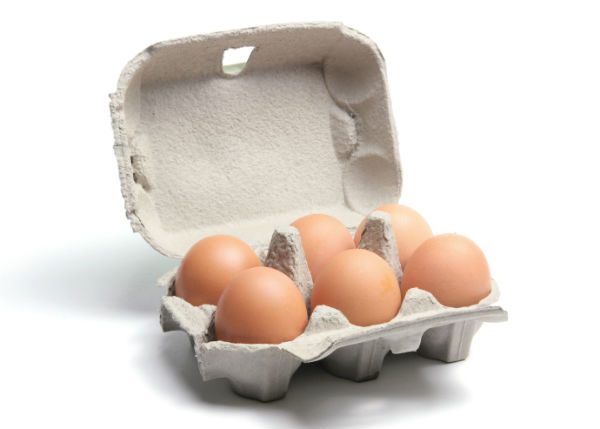It used to be that if you wanted to safely transport freshly laid chicken eggs, all you really had to do was retrieve selections from your own backyard coop (or that of a neighbor’s), carefully place them in a basket or apron skirt and walk a few yards to your kitchen. Aw, what a sweet little antiquated Norman Rockwell scenario.
There are certainly modern-day homesteaders and DIY enthusiasts who still keep that cluckin’, egg pluckin’ ritual alive and well, but for the most part, the rest of us rely on major corporations to satisfy our yolky desires.
With approximately
192 highly industrialized U.S. poultry farming operations in existence — the majority of which are located in California, Iowa, Indiana, Ohio and Pennsylvania — there’s a whole lot of egg trucking going on.
Imagine all of those protein-packed orbs enduring countless bumpy miles cooped up in the back of tractor trailers. In order to thwart unnecessary casualties along the way, the industry has come to rely on shock-absorbing packaging for close to a century now, and it’s been a real life saver for both the egg producers and the consumers who ultimately tote a dozen or so home with their other assorted groceries.
But are the old familiar egg cartons that we’ve grown to know and love actually sustainable? Thanks to comprehensive research conducted by northeastern U.S. grocery store chain Wegmans, it turns out that
the type of packaging material really does make all the difference. In a quest to green up preexisting cartons (which were made with 100% petroleum-based #6
Styrofoam, a material that municipal recycling programs rarely process due to its extensive environmental and financial drawbacks), Wegmans explored the cradle-to-grave footprint of all three common egg-packaging materials, including #1
PET plastic and 100% recycled paper pulp.
Wegmans’ sustainability team immediately ruled out #1 PET plastic packaging due to the inadequate egg protection that it offers and ultimately determined that paper pulp-based egg cartons are more appealing, but only by a margin.
While cardboard packaging deserves brownie points for its 100% recycled paper roots, its properties (which mirror that of lower-quality paper towels) bog down and even break machinery, making nationwide recycling programs incredibly hesitant to accept it. Adding insult to injury, paper-based egg cartons
don’t even biodegrade easily in today’s landfills because all of the necessary ingredients — air, moisture and microorganisms — are typically absent.
Paper-based egg cartons give Mother Nature even more of a headache when it comes to the amount of natural resources consumed during the pulping and drying process. Can you believe that Styrofoam versions are actually easier on the environment, using less water, natural gas and electric overall?
If your town’s recycling program fails to accept paperboard or polystyrene egg cartons and you live in the southern U.S., you might want to try
Publix supermarket (multiple locations throughout South Carolina, Tennessee, Alabama, Georgia and Florida
happily accept #6 polystyrene-Styrofoam containers); tear paperboard containers into tiny, easily compostable pieces; or donate your stash to an urban chicken farmer via one of
Meetup.com’s 61 global social groups. But you know what you
really want to do. You want to pull out your DIY guns!
- Puree fresh fruit, pour it into the 12 compartments of a thoroughly cleansed Styrofoam egg carton, add a Popsicle stick in each and freeze until solid.
- Create a neat finger-painting tray for messy budding artists.
- Spruce up a set of LED holiday lights by turning them into floral “fairy lights” adorned with recycled egg carton “petals.”
- Mini cupcake fans should appreciate the fact that their bite-sized goods will fit perfectly inside of recycled egg containers, enabling them to be transported to a dinner party with ease.
- You already knew that you could accommodate this year’s seedlings by filling each egg carton compartment with soil, water and a generous dose of TLC, right?
- Make fireplace, grill and camping stove starters by melting candle nubs and broken crayons in a double boiler and pouring the liquefied mixture into a cardboard egg carton. Then, add a liberal dose of recycled dryer lint, twigs and even sawdust to create tiny solidified fuel bombs that will help you to get your fire raging in no time.
- Keep your children entertained for hours on end with these creative egg carton repurposing projects.
- Use empty Styrofoam cartons as egg-shaped Easter candy molds filled with melted chocolate. Boost your bunny points by studding each with assorted crunchy-chewy goodies like jelly beans, toasted coconut, dried fruit, chopped-up candy bars, etc.
- Make a repurposed bulletin board for your home office.
- Protect fragile objects such as glass figurines, holiday ornaments, etc. when moving or placing them in storage.
- Keep sewing notions, craft items, art supplies, children’s small toys, handyman nuts/bolts/etc. well organized.
- Slow the spoilage of fragile fruit such as figs and tomatoes by placing them inside their own individual egg carton compartments.
- Grow Easter grass in individual paperboard egg carton “cells” and then dress them up like mini pastel baskets.
- To help boots maintain their perfect upright form (especially during the spring and summer months when they’re not in use), place a cardboard egg carton inside the opening of each.
